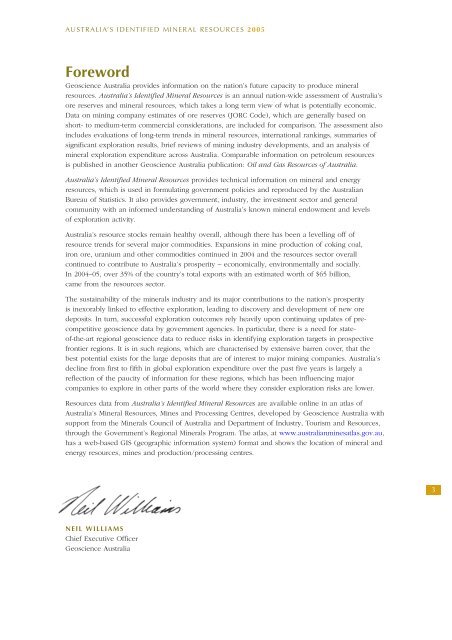australia's identified mineral resources 2005 - Geoscience Australia
australia's identified mineral resources 2005 - Geoscience Australia
australia's identified mineral resources 2005 - Geoscience Australia
Create successful ePaper yourself
Turn your PDF publications into a flip-book with our unique Google optimized e-Paper software.
AUSTRALIA’S IDENTIFIED MINERAL RESOURCES <strong>2005</strong><br />
Foreword<br />
<strong>Geoscience</strong> <strong>Australia</strong> provides information on the nation’s future capacity to produce <strong>mineral</strong><br />
<strong>resources</strong>. <strong>Australia</strong>’s Identified Mineral Resources is an annual nation-wide assessment of <strong>Australia</strong>’s<br />
ore reserves and <strong>mineral</strong> <strong>resources</strong>, which takes a long term view of what is potentially economic.<br />
Data on mining company estimates of ore reserves (JORC Code), which are generally based on<br />
short- to medium-term commercial considerations, are included for comparison. The assessment also<br />
includes evaluations of long-term trends in <strong>mineral</strong> <strong>resources</strong>, international rankings, summaries of<br />
significant exploration results, brief reviews of mining industry developments, and an analysis of<br />
<strong>mineral</strong> exploration expenditure across <strong>Australia</strong>. Comparable information on petroleum <strong>resources</strong><br />
is published in another <strong>Geoscience</strong> <strong>Australia</strong> publication: Oil and Gas Resources of <strong>Australia</strong>.<br />
<strong>Australia</strong>’s Identified Mineral Resources provides technical information on <strong>mineral</strong> and energy<br />
<strong>resources</strong>, which is used in formulating government policies and reproduced by the <strong>Australia</strong>n<br />
Bureau of Statistics. It also provides government, industry, the investment sector and general<br />
community with an informed understanding of <strong>Australia</strong>’s known <strong>mineral</strong> endowment and levels<br />
of exploration activity.<br />
<strong>Australia</strong>’s resource stocks remain healthy overall, although there has been a levelling off of<br />
resource trends for several major commodities. Expansions in mine production of coking coal,<br />
iron ore, uranium and other commodities continued in 2004 and the <strong>resources</strong> sector overall<br />
continued to contribute to <strong>Australia</strong>’s prosperity – economically, environmentally and socially.<br />
In 2004–05, over 35% of the country’s total exports with an estimated worth of $65 billion,<br />
came from the <strong>resources</strong> sector.<br />
The sustainability of the <strong>mineral</strong>s industry and its major contributions to the nation’s prosperity<br />
is inexorably linked to effective exploration, leading to discovery and development of new ore<br />
deposits. In turn, successful exploration outcomes rely heavily upon continuing updates of precompetitive<br />
geoscience data by government agencies. In particular, there is a need for stateof-the-art<br />
regional geoscience data to reduce risks in identifying exploration targets in prospective<br />
frontier regions. It is in such regions, which are characterised by extensive barren cover, that the<br />
best potential exists for the large deposits that are of interest to major mining companies. <strong>Australia</strong>’s<br />
decline from first to fifth in global exploration expenditure over the past five years is largely a<br />
reflection of the paucity of information for these regions, which has been influencing major<br />
companies to explore in other parts of the world where they consider exploration risks are lower.<br />
Resources data from <strong>Australia</strong>’s Identified Mineral Resources are available online in an atlas of<br />
<strong>Australia</strong>’s Mineral Resources, Mines and Processing Centres, developed by <strong>Geoscience</strong> <strong>Australia</strong> with<br />
support from the Minerals Council of <strong>Australia</strong> and Department of Industry, Tourism and Resources,<br />
through the Government’s Regional Minerals Program. The atlas, at www.australianminesatlas.gov.au,<br />
has a web-based GIS (geographic information system) format and shows the location of <strong>mineral</strong> and<br />
energy <strong>resources</strong>, mines and production/processing centres.<br />
3<br />
NEIL WILLIAMS<br />
Chief Executive Officer<br />
<strong>Geoscience</strong> <strong>Australia</strong>

















